Mohnish Dubey
An Explainable Natural Language Framework for Identifying and Notifying Target Audiences In Enterprise Communication
Aug 07, 2025Abstract:In large-scale maintenance organizations, identifying subject matter experts and managing communications across complex entities relationships poses significant challenges -- including information overload and longer response times -- that traditional communication approaches fail to address effectively. We propose a novel framework that combines RDF graph databases with LLMs to process natural language queries for precise audience targeting, while providing transparent reasoning through a planning-orchestration architecture. Our solution enables communication owners to formulate intuitive queries combining concepts such as equipment, manufacturers, maintenance engineers, and facilities, delivering explainable results that maintain trust in the system while improving communication efficiency across the organization.
Semantic Answer Type and Relation Prediction Task (SMART 2021)
Jan 10, 2022



Abstract:Each year the International Semantic Web Conference organizes a set of Semantic Web Challenges to establish competitions that will advance state-of-the-art solutions in some problem domains. The Semantic Answer Type and Relation Prediction Task (SMART) task is one of the ISWC 2021 Semantic Web challenges. This is the second year of the challenge after a successful SMART 2020 at ISWC 2020. This year's version focuses on two sub-tasks that are very important to Knowledge Base Question Answering (KBQA): Answer Type Prediction and Relation Prediction. Question type and answer type prediction can play a key role in knowledge base question answering systems providing insights about the expected answer that are helpful to generate correct queries or rank the answer candidates. More concretely, given a question in natural language, the first task is, to predict the answer type using a target ontology (e.g., DBpedia or Wikidata. Similarly, the second task is to identify relations in the natural language query and link them to the relations in a target ontology. This paper discusses the task descriptions, benchmark datasets, and evaluation metrics. For more information, please visit https://smart-task.github.io/2021/.
VANiLLa : Verbalized Answers in Natural Language at Large Scale
May 24, 2021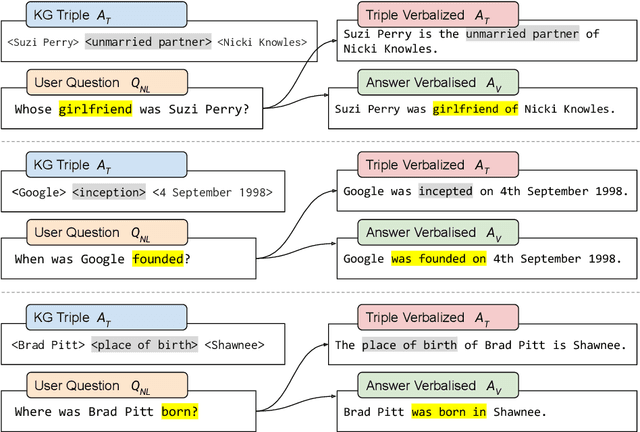
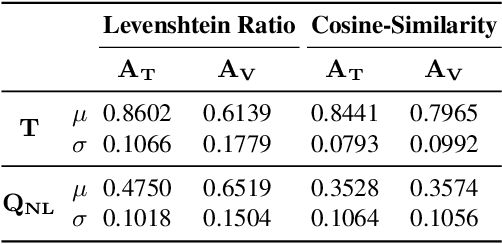
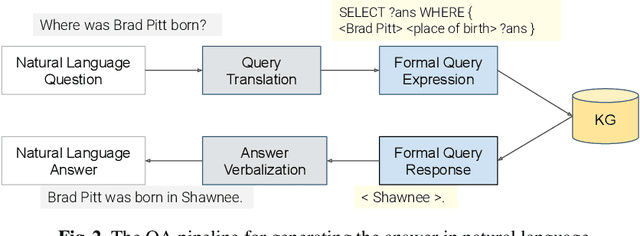
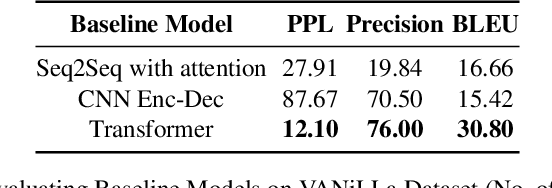
Abstract:In the last years, there have been significant developments in the area of Question Answering over Knowledge Graphs (KGQA). Despite all the notable advancements, current KGQA datasets only provide the answers as the direct output result of the formal query, rather than full sentences incorporating question context. For achieving coherent answers sentence with the question's vocabulary, template-based verbalization so are usually employed for a better representation of answers, which in turn require extensive expert intervention. Thus, making way for machine learning approaches; however, there is a scarcity of datasets that empower machine learning models in this area. Hence, we provide the VANiLLa dataset which aims at reducing this gap by offering answers in natural language sentences. The answer sentences in this dataset are syntactically and semantically closer to the question than to the triple fact. Our dataset consists of over 100k simple questions adapted from the CSQA and SimpleQuestionsWikidata datasets and generated using a semi-automatic framework. We also present results of training our dataset on multiple baseline models adapted from current state-of-the-art Natural Language Generation (NLG) architectures. We believe that this dataset will allow researchers to focus on finding suitable methodologies and architectures for answer verbalization.
SeMantic AnsweR Type prediction task at ISWC 2020 Semantic Web Challenge
Dec 01, 2020


Abstract:Each year the International Semantic Web Conference accepts a set of Semantic Web Challenges to establish competitions that will advance the state of the art solutions in any given problem domain. The SeMantic AnsweR Type prediction task (SMART) was part of ISWC 2020 challenges. Question type and answer type prediction can play a key role in knowledge base question answering systems providing insights that are helpful to generate correct queries or rank the answer candidates. More concretely, given a question in natural language, the task of SMART challenge is, to predict the answer type using a target ontology (e.g., DBpedia or Wikidata).
PNEL: Pointer Network based End-To-End Entity Linking over Knowledge Graphs
Aug 31, 2020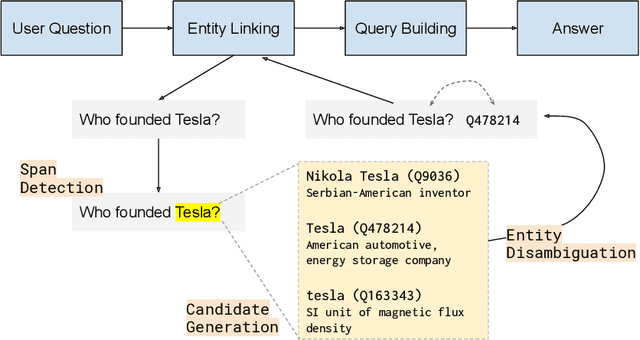

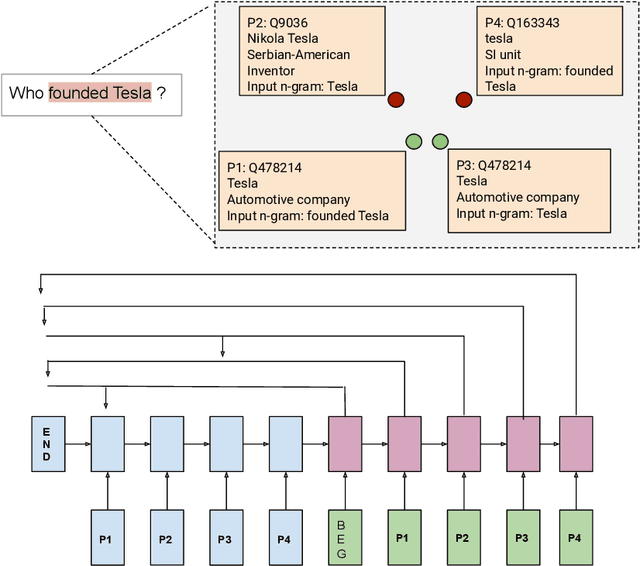

Abstract:Question Answering systems are generally modelled as a pipeline consisting of a sequence of steps. In such a pipeline, Entity Linking (EL) is often the first step. Several EL models first perform span detection and then entity disambiguation. In such models errors from the span detection phase cascade to later steps and result in a drop of overall accuracy. Moreover, lack of gold entity spans in training data is a limiting factor for span detector training. Hence the movement towards end-to-end EL models began where no separate span detection step is involved. In this work we present a novel approach to end-to-end EL by applying the popular Pointer Network model, which achieves competitive performance. We demonstrate this in our evaluation over three datasets on the Wikidata Knowledge Graph.
IQA: Interactive Query Construction in Semantic Question Answering Systems
Jun 25, 2020



Abstract:Semantic Question Answering (SQA) systems automatically interpret user questions expressed in a natural language in terms of semantic queries. This process involves uncertainty, such that the resulting queries do not always accurately match the user intent, especially for more complex and less common questions. In this article, we aim to empower users in guiding SQA systems towards the intended semantic queries through interaction. We introduce IQA - an interaction scheme for SQA pipelines. This scheme facilitates seamless integration of user feedback in the question answering process and relies on Option Gain - a novel metric that enables efficient and intuitive user interaction. Our evaluation shows that using the proposed scheme, even a small number of user interactions can lead to significant improvements in the performance of SQA systems.
EARL: Joint Entity and Relation Linking for Question Answering over Knowledge Graphs
Jun 25, 2018
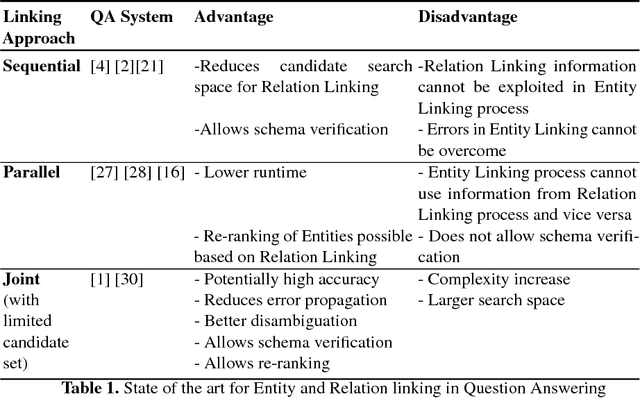
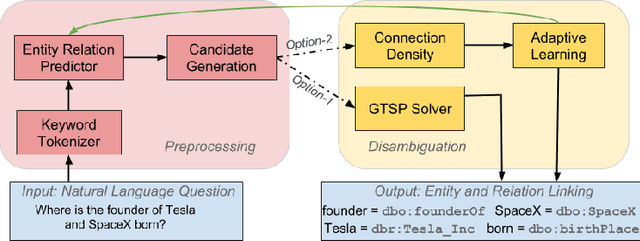
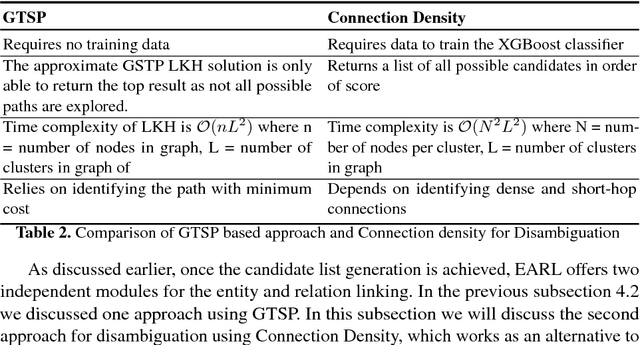
Abstract:Many question answering systems over knowledge graphs rely on entity and relation linking components in order to connect the natural language input to the underlying knowledge graph. Traditionally, entity linking and relation linking have been performed either as dependent sequential tasks or as independent parallel tasks. In this paper, we propose a framework called EARL, which performs entity linking and relation linking as a joint task. EARL implements two different solution strategies for which we provide a comparative analysis in this paper: The first strategy is a formalisation of the joint entity and relation linking tasks as an instance of the Generalised Travelling Salesman Problem (GTSP). In order to be computationally feasible, we employ approximate GTSP solvers. The second strategy uses machine learning in order to exploit the connection density between nodes in the knowledge graph. It relies on three base features and re-ranking steps in order to predict entities and relations. We compare the strategies and evaluate them on a dataset with 5000 questions. Both strategies significantly outperform the current state-of-the-art approaches for entity and relation linking.
 Add to Chrome
Add to Chrome Add to Firefox
Add to Firefox Add to Edge
Add to Edge